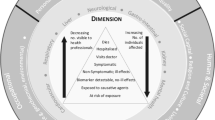Abstract
Recent evidence from European research challenges the adequacy of current U.S. exposure guidelines for underground mine radiation. This study traces the history of government regulatory agency and industry response to the hazard of excessive mine radiation in the uranium industry in Colorado some 30 years ago. Problem-solving activity by government agencies and companies is shown to coincide with how visible the health hazard to uranium miners becomes. Hazard visibility and key problem-solving variables are defined and measured. The article also discusses a number of social factors that affect societal response to evidence of an occupational health hazard. Those factors include (1) the elusiveness of the disease and its symptoms, (2) the social class of the victim, (3) the level of medical and scientific interest in its cause and cure, and (4) the economic costs of the disease.
Similar content being viewed by others
References
Archer VE, et al: Factors in exposure-response relationships of radon daughter injury, 1978. Presented at the 23rd annual meeting of the Health Physics Society, Minneapolis, June 18–23, 1978.
Radon Guidelines May be Weak. TheDenver Post, Sept. 4, 1979.
Joint Committee on Atomic Energy: Radiation Exposure of Uranium Miners. Hearing, 90th Congress, 1st Session, Washington, DC, Government Printing Office, 1967.
Woodward and Fondiller: Probable Numbers and Costs through 1985 of Lung Cancer Cases. Prepared for the Colorado Industrial Commission, Colorado, 1967.
Holaday D, et al: An interim report of a health study of the uranium mines and mills. Unpublished paper prepared for the Federal Security Agency, Public Health Service, Division of Occupational Health and the Colorado State Department of Public Health (May).
Jacoe PW: Report on the uranium study. Unpublished paper prepared for the Colorado Department of Public Health, Division of Occupational and Radiological Health, 1964.
Rock RL, Walker DK: Controlling Employee Exposure to Alpha Radiation in Underground Uranium Mines. 1. Washington, DC, Department of Interior, Bureau of Mines.
National Research Council: Epidemiological Studies of Uranium Mines. A report prepared for Interagency Uranium Mining Review Group, 1971.
Lundin FE Jr, Wagoner JK, Archer VE:Radon Daughter Exposure and Exposure and Respiratory Cancer: Quantitative and Temporal Aspects. Washington, DC, Public Health Service, 1971.
Metzger HP:The Atomic Establishment. New York, Simon and Schuster, 1972.
Enloe CH:The Politics of Pollution in a Comparative Perspective. New York, David McKay Co, 1975.
Molotch H: Oil in Santa Barbara and power in America.Sociological Inquiry 40 131–144, 1970.
Huddle N, Michael R:Island of Dreams: Environmental Crisis in Japan. Autumn Press, 1977.
Pearson J:The Process of Solving an Industrial Health Hazard. Unpublished doctoral dissertation, Princeton University, 1974.
Pearson J:A Sociological Analysis of the Reduction of Hazardous Radiation in Uranium Mines. U.S. Department of Health, Education and Welfare. Washington, DC, National Institute for Occupational Safety and Health, 1975.
Pearson J: Organizational response to occupational injury and disease: The case of the uranium miner.Social Forces 57(1) 23–41.
Colorado Bureau of Mines: Report for Years 1950–1970. Denver, Colo.
Atomic Energy Commission:Radiation Control Study. Grand Junction, Colorado, 1968.
Colorado Mining Association:National Western Mining Conference Resolutions and Declarations of Policy. Denver, Colorado, 1950–1970.
Joint Committee on Atomic Energy:Employee Radiation Hazards and Workmen's Compensation. Washington, DC, Government Printing Office, 1959.
TheDenver Post, Feb. 8, 1975. P 17.
TheDenver Post, Dec. 16, 1960. P 13.
TheDenver Post, Aug. 30, 1962. P 19.
TheDenver Post, March 10, 1967. P 34.
TheDenver Post, April 20, 1967. P 67.
TheDenver Post, April 24, 1967. P 13.
TheDenver Post, May 21, 1967, P 37.
TheDenver Post, May 22, 1967. P 16.
Koch L (Continental Oil Company): Personal interview. Denver, Colorado, 1973.
Loch L (Continental Oil Company): Personal interview, Denver, Colorado, 1973.
Saccomanno G: Incidence of cancer of the lung among uranium miners. 1954–1972. Unpublished paper.
TheDenver Post, Sept. 3, 1979. P 2.
Metzger HP:The Atomic Establishment. New York, Simon and Schuster, 1972.
Johnson JC: (Director, Division of Raw Materials, Atomic Energy Commission): Uranium Production in the U.S.: A speech delivered to the Atomic Industrial Forum. New York City, 1957.
Atomic Energy Commission: Release No. 0-178: AEC Seeks Public Comment on Proposed Uranium Supply Policies, 1971.
Atomic Energy Commission: Statistical data of the uranium industry. Unpublished, 1972. P 8.
Blake N (Director of Colorado Bureau of Mines): Personal interview, Denver, Colorado, 1972.
TheDenver Post, Sept. 4, 1979. P 16.
Additional information
Dr. Pearson is Assistant Professor in the Department of Sociology, University of Denver, Denver, Colorado 80207.
Rights and permissions
About this article
Cite this article
Pearson, J. Hazard visibility and occupational health problem solving: The case of the uranium industry. J Community Health 6, 136–147 (1980). https://doi.org/10.1007/BF01318981
Issue Date:
DOI: https://doi.org/10.1007/BF01318981




